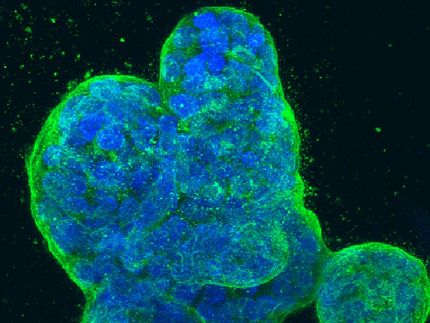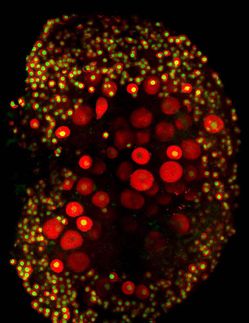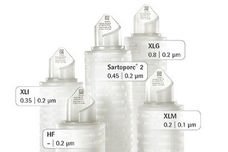Enzyme Crystal Structure Reveals "Unexpected" Genome Repair Functions
New Discovery Could Help Improve Some Forms of Chemotherapy
Scientists at The Scripps Research Institute and Lawrence Berkeley National Laboratory have determined the crystal structure of an enzyme called xeroderma pigmentosum group B (XPB) helicase, identifying several unexpected functions and helping to address important questions about the enzyme's role in DNA transcription and repair. The research illuminated, for the first time, the roles played by the important XPB protein in recognizing blockages in reading the DNA code and in initiating an efficient method of repair. The discovery may be useful in the quest to develop new forms of chemotherapy.
"The results suggest a previously unsuspected mechanism for the repair process," notes project leader John Tainer, who is a professor at Scripps Research, member of Scripps Research's Skaggs Institute for Chemical Biology, and co-principal investigator of the Structural Cell Biology of DNA Repair project, Life Sciences Division, at the Lawrence Berkeley Lab. "We were surprised by the findings."
All the information for heredity is encoded in DNA molecules that are constantly under attack from sources inside and outside the body - by sunlight, ionizing radiation, other environmental carcinogens, and free radicals from the normal cellular metabolism. Surprisingly, most of this damage comes from the chemical reactions that are the normal processes needed for life, so life is impossible without DNA repair even in the absence of environmental toxins.
DNA damage ranges from one or a few altered nucleotides in a single strand of the double helix, to breaks in one or both strands and crosslinks between the two strands. To prevent accumulation of mutations and the production of altered proteins, cells must deploy an arsenal of repair mechanisms to excise and replace defective nucleotides, reconnect broken strands, and patch up other kinds of damage. As most damage comes from endogenous sources generated by the cellular metabolism, the impact of environmental and other mutagens depends upon the cell's ability to repair DNA damage, and this processes depends upon the accurate assembly of molecular machines for DNA repair such as the newly characterized XPB helicase.
Mutations that cause changes in these machines can block these DNA repair processes or even uncouple their normally coordinated actions to result in cancer and degenerative diseases associated with aging. This relationship is reflected by the extremely high cancer predisposition of individuals with hereditary defects in DNA-repair processes.
In xeroderma pigmentosum patients, for example, exposure to sunlight typically causes hyper-pigmented skin that is dry and parchment-like, and is followed by multiple skin cancers. If carefully shielded from ultraviolet light, for example by window filters and protective clothing, many xeroderma pigmentosum sufferers can lead seemingly normal lives. Xeroderma pigmentosum results from mutations in any one of seven genes, labeled XPA through XPG, which are involved in the well-understood DNA repair mechanism called nucleotide-excision repair.
The research reported by this new study approached the complex repair machinery by looking at a simpler system involving the XPB helicase from an archaea, a single-cell organism analogous to bacteria, in many ways resembling the nucleus or core of human cells. Helicases are enzymes that unwind or separate the strands of the nucleic acid double helix, an action that is critical to transcription and nucleotide excision repair, as well as other cell processes.
Nucleotide excision repair, a critical defense mechanism that removes DNA lesions caused by the mutating effects of sunlight (ultraviolet light) and toxic chemicals is also central to the success of the anticancer drug cisplatin, since cisplatin works by initiating the process of DNA repair, in turn activating apoptosis or programmed cell death when the repair process fails. "Because chemotherapeutic agents like the chemotherapy drug cisplatin and radiation therapy work by essentially damaging DNA, any new understanding of the DNA repair mechanism could mean potential improvements in the treatment of cancer," Tainer says.
Prior to this study, there were no specific models for how XPB acts in DNA separation either to initiate transcription or to begin nucleotide excision repair. There were also no models for the role that XPB, which is an essential subunit of Transcription Factor IIH (TFIIH) functional assembly complex, might play in changing conformations for TFIIH's alternate roles in either transcription or DNA repair.
The XPB crystal structures developed by the researchers identified unexpected functional domains for XPB. Research Associate Li Fan of Scripps Research, the first author of the study, notes, "We were surprised when we found that XPB contains a domain structurally similar to the mismatch recognition domain of a bacterial DNA repair protein MutS. MutS helps recognize and repair mismatched DNA in E. coli. These two proteins have little sequence similarity. Biochemical assays following this discovery indicate that this domain allows XPB to interact with damaged DNA and enhances its unwinding activity on damaged DNA."
The report suggests that unknown protein and DNA interactions at transcription sites activate XPB within the TFIIH complex to allow it to start the DNA unwinding process.
"Even though TFIIH does not act directly in initial damage recognition, the interaction of XPB with the DNA lesion suggests that XPB plays a role in switching TFIIH from transcription mode to nucleotide excision repair," Tainer says. "The structural biochemistry of XPB that we discovered shows an unexpected molecular mechanism by which XPB plays a key role in determining exactly how TFIIH functions, whether in transcription or repair mode."


























































